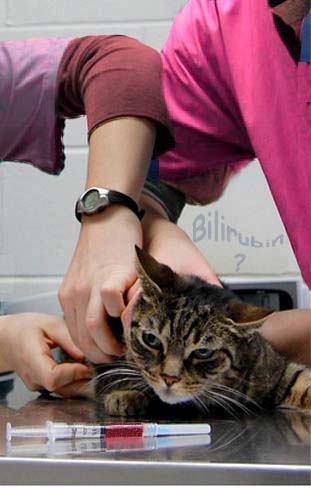Why Is My Dog Or Cat’s Blood Bilirubin Level High Or Low?
Ron Hines DVM PhD
 See What Normal Blood & Urine Values Are
See What Normal Blood & Urine Values Are
 Causes Of Most Abnormal Blood & Urine Tests
Causes Of Most Abnormal Blood & Urine Tests
The Bilirubin Level In Your Dog Or Cat’s Blood = Total bilirubin, TBIL
Read articles on similar topics here: Jaundice, Icterus Index, Urobilinogen, Bilirubin in urine
Bilirubin is a yellowish-orange pigment. It is composed of the residues of heme, which is part of the hemoglobin in your dog or cat’s blood. It remains to be reprocessed when your pet’s red blood cells that contain it reach the limits of their lifespan. That is a normal process. The red blood cells in your dog only live for about 3 months, and only about 2 months in your cat.
It is the job of certain cells in your dog or cat’s liver to concentrate, process and excrete this bilirubin heme residue into your pet’s bile. From there, much of it eventually leaves your dog or cat’s body in its feces. Insubstantial amounts of bilirubin (a little) leave healthy dogs through their urine – none in healthy cats. Bilirubin is responsible for the reddish brown color of old bruises and the yellow skin of jaundiced pets. When there is too much bilirubin in circulation, it is most noticeable in the whites (sclera) of your pet’s eyes, the inside skin of its ears and in its gums; particularly when your pet is also anemic. Your dog or cat’s lab work will report the value as Total Bilirubin (TB). It may also report what portion of the bilirubin has already been processed by the pet’s liver (Direct = post-hepatic or conjugated bilirubin) and what portion has not yet done so (Indirect = pre-hepatic or unconjugated bilirubin). Those two later values give vets hints as to whether too much heme is being produced (i.e. too many destroyed red blood cells) or if the liver is unable to process the normal quantities of discarded heme that all pets produce.
In some cases where direct (prehepatic) bilirubin is high, the liver is actually working well in its duties, but there is blockage of one sort or another in the gallbladder and duct system that conveys bilirubin from the pet’s liver to its upper intestine. In other cases, direct bilirubin is high because of hemolytic anemia. But most jaundiced sick dogs and cats have elevations in both types of bilirubin. Still, how much of one versus the other sometimes gives your veterinarian a hint to what the underlying cause might be. One of the most dramatic spikes in bilirubin occurs when a pet’s bile drainage duct system becomes blocked (such as with a gallstone(s)). Once a liver/bile duct crisis or blood crisis passes, it can take a long time (one to several weeks) for your pet’s blood bilirubin values to return to normal.
Health Problems That Can Cause Your Pet’s Bilirubin Values To Be High (hyperbilirubinemia):
Chronic liver disease is the most common cause of high bilirubin levels in dogs and cats. That can be from a wide variety of liver diseases:
In cats, cholangiohepatitis (triad disease) is a common cause.
In cats, one needs to also consider hepatic lipidosis. Particularly, when your cat’s blood alkaline phosphatase (AP) level is significantly above normal and your cat cannot or refuses to eat.
In cats, cancers (e.g. lymphoma) associated with age or the feline leukemia virus, or the debility of feline immunodeficiency virus or cats that have developed FIP can all be responsible for high bilirubin levels. Any form of liver cancer in dogs can have the same effect. The liver is a vast blood sieve that can trap tumorous cells that have broken free from cancers in any part of your pet’s body. Those secondary (metastatic) tumors in the liver of elderly cats and dogs can lead to elevated blood bilirubin levels as they grow in mass and begin to prevent normal liver function.
As I mentioned earlier, any obstruction to the flow of bile to the intestines such as gall stones, biliary obstructions or chronic biliary (gallbladder) inflammation can also raise blood bilirubin levels in dogs and cats.
Exposure to chemicals and medications that are potentially toxic to your pet’s liver (hepatotoxic) is sometimes another cause of high blood bilirubin levels. That is particularly true of Tylenol™ (acetaminophen) if given to cats. (read here) I have also seen high bilirubin results when dogs consumed dog kibble that contained moldy corn (aflatoxin).
Toxoplasmosis and leptospirosis infections sometimes causes liver shutdown, leading to high blood bilirubin.
The red blood cell destruction of autoimmune disease in dogs (autoimmune hemolytic anemia) and blood parasite infections in dogs and cats (e.g. haemobartonella) can also result in high bilirubin levels.
Much rarer causes in dogs are copper storage disease, liver scarring (hepatic fibrosis/cirrhosis) and the infectious canine hepatitis virus. (read here) High bilirubin levels are also occasionally seen in pancreatitis – probably because pancreatic enzymes leak into the abdomen with the potential to cause severe inflammation.
High levels of free hemoglobin in your pet’s circulation from any cause will result in high bilirubin. Hemoglobin belongs in your pet’s red blood cells, not free in the blood. Some of that free hemoglobin can also spill over into your pet’s urine. So read about some additional causes of free hemoglobin that I might have neglected to mention in this article here & here.

When the bilirubin is primarily the direct (pre-hepatic) form that is elevated, the causes, roughly in their order of frequency, are: autoimmune disease, infectious diseases such as leptospirosis, hepatic lipidosis in cats, drug or vaccine reactions, cancer, toxins (such as zinc or onions), severe heartworm disease in dogs (caval syndrome), DIC, snake bite or the bite of other venomous creatures, abnormally low blood phosphorus, a mismatched blood transfusion, incompatible blood types between mother and kittens (neonatal isoerythrolysis) and, in fading kittens and puppies, genetic defects.
When the bilirubin is primarily the indirect (post-hepatic) form that is elevated, the causes often listed in order of frequency are: Gall bladder issues, pancreatitis, cancer of the digestive tract or its lymph nodes, upper intestinal obstructions, peritonitis, and septicemia.
Health Problems That Can Cause Your Pet’s Bilirubin Values To Be Low (hypobilirubinemia):
I know of none that have been reported in dogs or cats. Idexx Laboratories lists blood sample exposure to UV light or room air, delays in analysis, centrifugation prior to analysis or ascorbic acid (vitamin C) as possible reasons for falsely low bilirubin results.
Some believe that normal bilirubin values are protective in humans – but in poorly defined ways. (read here) In humans, caffeine, antibiotics and barbiturates are said to lower bilirubin levels.
Falsely High Readings
Large amounts of lipids (triglycerides and cholesterol) in the blood sample that your pet supplied can make its bilirubin level appear higher than it really is. The most common reason for high blood lipids is a recent meal. A blood sample that was hemolyzed during collection, or before it was placed into the analytical machine, can also make your pet’s bilirubin level appear higher than it really is.
Complementary Tests:
Request a test that splits total bilirubin into its two component values, indirect bilirubin and direct bilirubin. A standard CBC/ WBC and blood chemistry panel – including the liver enzymes, ALP, ALT and GT. Bile acids test. Tests regarding pancreatic function (amylase, pancreas-specific lipase, TLI). X-rays and ultrasound examination of your pet’s liver. Liver biopsy. The expected elevated cholesterol levels of hepatic dysfunction (=cholestasis). Normal bile acids and other liver enzymes make the likelihood of excessive red blood cell destruction the more likely cause of excess bilirubin in your dog or cat’s blood.
It is not that unusual for a cat or a dog that appears healthy to occasionally have moderately higher than normal bilirubin, ALT, or Alkaline Phosphatase (AP) tests with no apparent explanation. Physicians face the same problem as veterinarians when deciding what to do in those situations. (ask me for AlkalinePhosGiannini2007) I generally suggest that the test be repeated in 2 weeks to see if the results are still abnormal. Many times they have improved. I am also more concerned when a number of liver-related tests are a bit high than when only one is. Of course, if your pet is feeling poorly, has lost weight or the result was quite high, waiting before consulting your veterinarian further is never a good idea.
DxMe
You are on the Vetspace animal health website
Visiting the products that you see displayed on this website help pay the cost of keeping these articles on the Internet.


